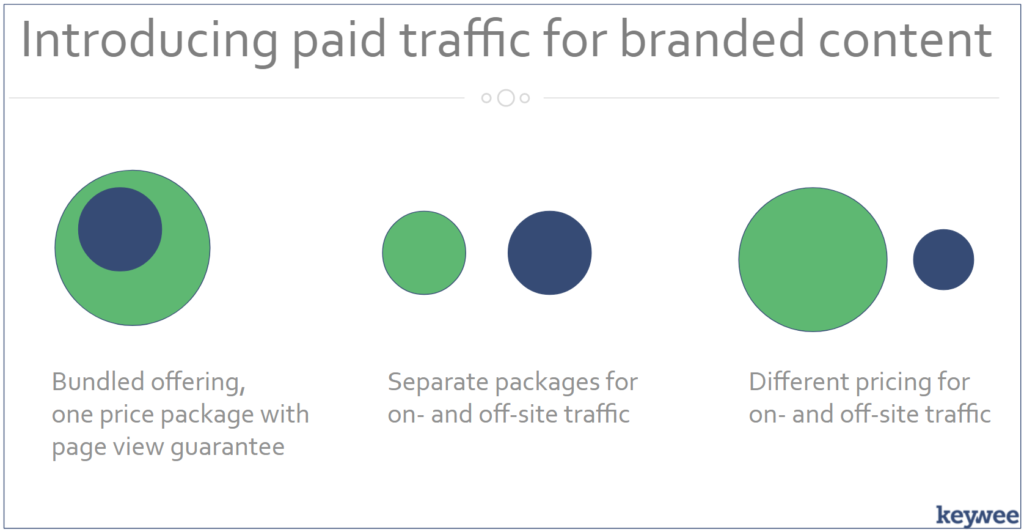The branded content market is exploding. Some estimates peg the market size for branded content at $20 billion over the next five years. With so much at stake for a key component of content marketing, it’s easy to understand why it’s important to so many people. Update – Three years after we wrote this article branded content is expected to reach a yearly spend of $13.4 billion, double the initial estimate.
When a brand partners with a publisher for a branded content campaign, the brand is buying a few things: the publisher’s storytelling expertise, its influence and thought leadership, and access to an engaged, relevant target audience.
Unfortunately, getting this audience to interact with branded content articles is becoming increasingly hard. Organic traffic isn’t what it used to be, especially on social media, and branded content specifically doesn’t get much SEO love.
To combat this trend, it’s common for publishers to acquire audiences when there is a positive ROI. For editorial content, this means buying traffic for profitable audience development and subscriptions. For branded content, it means buying traffic as part of a bundled offering that may include acquisition as part of the cost or may break it out as a separate line item.
Branded content campaigns may also employ paid content distribution strategies if the publisher guaranteed impressions to the content piece, and is not meeting the goal with organic traffic. To maintain a good relationship with the brand for the long term, publishers may sacrifice short term profits.
Paid branded content distribution has more than doubled year over year.
In 2017, we’ve seen growth in paid content distribution overall, with publishers doubling their spending on Facebook in the past 18 months for multiple content marketing objectives. Paid branded content distribution has been growing faster than paid editorial distribution – it has more than doubled year over year (113% growth), and its share of total publisher spend on Facebook grew from 0.8% in Q3’16 to 9.5% in Q3’17 – as presented in the chart below. These figures are based on Keywee’s analysis of data from over 400 publishers and one million articles promoted on Facebook.
We have a few tips that could help you with your paid content distribution on social media and are also applicable for your branded content efforts.
- Choose the right goal.
It might sound simplistic, but we’ve helped some of our partners getting better results by simply restructuring their distribution plan and aligning it to their client’s KPI. If the brand you work with is interested in video views and brand awareness, for example, it would probably be best to use the video asset in your creative and to tell Facebook to optimize the delivery for it.
- Granularity is good for goal planning.
If your partner has a couple of goals that you need to meet, don’t try to accomplish them in one fell swoop. It might be slightly more cumbersome to double the number of assets you promote, but it will help Facebook deliver the best results for each one. For example, if your goal is at least 90,000 clicks AND 1,500,000 ad impressions there are a few ways this may go down:- A campaign optimizing for impressions – this will likely deliver too few clicks, causing your team to be forced to add budgets towards the end of the campaign, scaling the spend rapidly and getting worse prices than if you had been steadily optimizing for clicks.
- A campaign optimizing for clicks – a better scenario than the previous. As clicks are further down the content funnel than ad impressions, if you achieve this click goal you should also achieve your impressions goal. If you don’t achieve your impressions goal you will have to add more budgets and again, spend quickly which will likely reduce efficiency.
- Two campaigns, each optimizing for a different goal.
Quickly after launching your campaign, you’ll be able to calculate the budget each campaign needs to meet its goal. Each campaign will be spending in the most effective way and the overall cost is expected to be the lowest possible, with the maximal budget flexibility.
- Complimentary values
We covered this in-depth here, but when you’re adding paid distribution to the equation the connection between you and the brand is even more important. The audience you’ll reach doesn’t necessarily know who you are and what you stand for, so it’s your first impression for them as well, make sure to associate yourself with brands that’ll attract the kind of users you want to turn into loyal readers. - Test rigorously
Paid content distribution is a great opportunity to A/B test different messages and obtain insights that you can’t get during a purely-organic based campaign. From the creative assets to the audience that’s interested in your content.
About Keywee
At Keywee, we make stories relevant and powerful for the world’s best storytellers — like The New York Times, The BBC, National Geographic, Forbes, and Red Bull.
Today, people aren’t coming to websites to search for content — stories find their audiences in feeds and apps. The upshot? Distribution is now the key for effective storytelling. Keywee’s platform unlocks audience insights using AI and data science, and infuses them into every step of the storytelling process: from topic selection, to story creation, to distribution and optimization. Keywee is backed by leading investors such as Google’s Eric Schmidt and The New York Times, and has been a fast-growing, profitable startup since its inception. To learn more, request a demo here.



